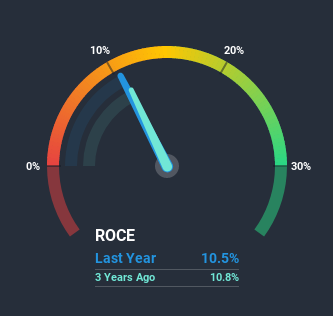If we want to find a stock that could multiply over the long term, what are the underlying trends we should look for? In a perfect world, we'd like to see a company investing more capital into its business and ideally the returns earned from that capital are also increasing. If you see this, it typically means it's a company with a great business model and plenty of profitable reinvestment opportunities. Having said that, from a first glance at KSB (NSE:KSB) we aren't jumping out of our chairs at how returns are trending, but let's have a deeper look.
What is Return On Capital Employed (ROCE)?
If you haven't worked with ROCE before, it measures the 'return' (pre-tax profit) a company generates from capital employed in its business. The formula for this calculation on KSB is:
Return on Capital Employed = Earnings Before Interest and Tax (EBIT) ÷ (Total Assets - Current Liabilities)
0.10 = ₹911m ÷ (₹14b - ₹5.6b) (Based on the trailing twelve months to March 2020).
Therefore, KSB has an ROCE of 10%. That's a relatively normal return on capital, and it's around the 11% generated by the Machinery industry.
View our latest analysis for KSB

Above you can the how the current ROCE for KSB's compares to it's prior returns on capital, but you can only tell so much from the past. If you'd like, you can check out the forecasts from the analysts covering KSB here for free.
So How Is KSB's ROCE Trending?
In terms of KSB's historical ROCE movements, the trend isn't fantastic. Over the last five years, returns on capital have decreased to 10% from 13% five years ago. However it looks like KSB might be reinvesting for long term growth because while capital employed has increased, the company's sales haven't changed much in recent times. It's worth keeping an eye on the company's earnings from here on to see if these investments do end up contributing to the bottom line.
In Conclusion...
To conclude, we've found that KSB is reinvesting in the business, but returns have been falling. Since the stock has declined 11% over the last five years, investors may not be too optimistic on this trend improving either. Therefore based on the analysis done in this article, we don't think KSB has the makings of a multi-bagger.
On a separate note, we've found 1 warning sign for KSB you'll probably want to know about.
While KSB may not currently earn the highest returns, we've compiled a list of companies that currently earn more than 25% return on equity. Check out this free list here.
If you decide to trade KSB, use the lowest-cost* platform that is rated #1 Overall by Barron’s, Interactive Brokers. Trade stocks, options, futures, forex, bonds and funds on 135 markets, all from a single integrated account.Promoted
Valuation is complex, but we're here to simplify it.
Discover if KSB might be undervalued or overvalued with our detailed analysis, featuring fair value estimates, potential risks, dividends, insider trades, and its financial condition.
Access Free AnalysisThis article by Simply Wall St is general in nature. It does not constitute a recommendation to buy or sell any stock, and does not take account of your objectives, or your financial situation. We aim to bring you long-term focused analysis driven by fundamental data. Note that our analysis may not factor in the latest price-sensitive company announcements or qualitative material. Simply Wall St has no position in any stocks mentioned.
*Interactive Brokers Rated Lowest Cost Broker by StockBrokers.com Annual Online Review 2020
Have feedback on this article? Concerned about the content? Get in touch with us directly. Alternatively, email editorial-team@simplywallst.com.
About NSEI:KSB
KSB
Manufactures and sells power-driven pumps and industrial valves in India and internationally.
Flawless balance sheet with solid track record and pays a dividend.
Similar Companies
Market Insights
Community Narratives



